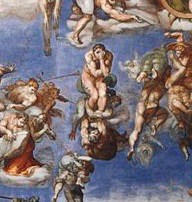Go here for the complete article.
Bad News; Good News

Believers, both individually and corporately, need to present the truth about God’s love and holiness. Yet—and this is our fourth point—we seem to have failed to understand that the good news of the gospel can be seen for how wonderful it is only against the backdrop of its bad news about sin, accountability to a holy God, and certain judgment. Again, God is holy and perfect, and He must judge sin. As we say in our presentation of how to become a Christian, “While we might not think of our violations as being all that extreme, even the smallest infraction in our eyes is enough to make us guilty before God. The penalty for sin is death—and not just physical death, but spiritual death, eternal separation from God forever (see Matt. 7:23; 25:41,46; see these verses in context here; also see Rom. 6:23).”
Oh, we don’t like this! Christian apologist Greg Koukl explains,
 It is hard to imagine anything in religion more repugnant to people than the wrath of God, and it is easy to see why.…
It is hard to imagine anything in religion more repugnant to people than the wrath of God, and it is easy to see why.…
[For one thing, t]he notion of a “vengeful” God strikes us as inconsistent with a God of love. This seems right at first, but the complaint is based on a misunderstanding. God’s love is not a thing in itself, so to speak, but is tied, like all of his attributes, to his goodness, the very goodness we are inclined to question when evil runs rampant. “Why doesn’t God do something?” we wonder. Yet we cry foul when we learn God will do something decisive about evil and we are the evildoers.”1
Later in his book, Koukl shows how God’s love, God’s wrath, and Jesus’ death are intertwined.
Jesus came to earth to save sinners. The statement is so common to our ears, it is easy to miss its significance. Save means to “rescue from imminent danger.” Jesus came to rescue us because we were in danger. What was the danger? What was Jesus rescuing from? Here is the answer. Jesus did not come to rescue us from our ignorance or our poverty or our oppressors or even from ourselves. Jesus came to rescue us from the Father.2
Remember, the King is angry. He is the one who is offended. He is the one who is owed. He is the Sovereign we have rebelled against, the father we have disobeyed, the friend we have betrayed. And that is a dangerous place for us to be. Jesus said, “Do not fear those who kill the body, but are unable to kill the soul, but rather fear him who is able to destroy both soul and body in hell.” Later in the Story we learn, “It is a terrifying thing to fall into the hands of the living God.”3
But we’d much rather talk about God’s love—and that’s what we do! While the Church in the 16th century made the mistake of emphasizing God’s wrath over His love (and didn’t really talk about His wrath in full accordance with biblical teaching), the church today is making the opposite mistake. We do need to talk about God’s love, but in the context of a proper emphasis on His justice and wrath.

Copyright © 2017 by B. Nathaniel Sullivan. All rights reserved.
Unless otherwise indicated, Scripture has been taken from the New King James Version®. Copyright © 1982 by Thomas Nelson, Inc. Used by permission. All rights reserved.
Scriptures marked NASB are taken from the NEW AMERICAN STANDARD BIBLE®, Copyright © 1960,1962,1963,1968,1971,1972,1973,1975,1977,1995 by The Lockman Foundation. Used by permission.
Notes:
1Gregory Koukl, The Story of Reality: How the World Began, How It Ends, and Everything Important that Happens in Between, (Grand Rapids: Zondervan, 2017), 97.
2At this point, Koukl provides this clarification in a footnote: “Jesus saves us from the Father, but His intention is not at odds with the Father since it was the Father who out of love, sent Jesus to rescue the world in the first place.”
3Koukl, 117. Scripture quotations are from Matthew 10:28 and Hebrews 10:31, respectively, New American Standard Bible.
image credit: top image: www.lightstock.com